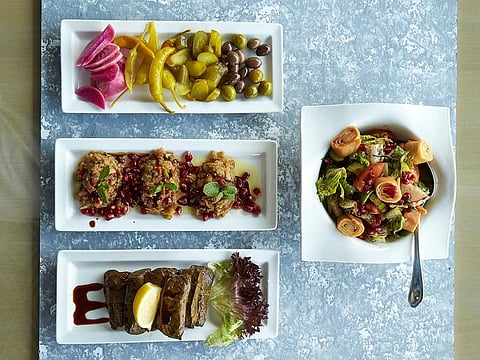Meet the star of Syrian cuisine: The Aleppo chilli paste
The spicy, citrusy and slightly fruity pepper is Syria’s ambassador to the culinary world

Crushed to perfection for seasoning, ground into a distinctly flavourful paste or just added whole to salads – the Aleppo chilli has carved itself a special niche in the culinary world. The Aleppo or Halabi pepper, which comes from the northern Syrian city of Aleppo or Halab – has been used for centuries, to season kebabs, stews, and sauces and this is what distinguishes Syrian cuisine from all others in the Middle East.
“The best Syrian food is from Aleppo. We have so many things in Aleppo cuisine which are good, but one thing that is special that you can only find in Halab is the chilli paste,” Chef Ali Fakhrrdine, the Chief Executive Chef of the newly opened Sharjah eatery Qasr Halab told the Food team of Gulfnews.com.
It is this chilli paste that turns popular Middle Eastern mezzehs (appetisers) and main courses like yalanji (stuffed grape leaves), kababs and kibbe distinctly Syrian. What adds to the special Syrian flavours is that the chilli paste or Shatta Halabiya has two versions – spicy and sweet.
The best Syrian food is from Aleppo. We have so many things in Aleppo cuisine which are good, but one thing that is special that you can only find in Halab is the chilli paste.

“You can find vine leaves in several countries in the Middle East – Lebanon, Jordan or Egypt. But in Aleppo there is a special touch because they put their sweet chilli paste along with pomegranate molasses in vine leaves. That gives it a special sweet flavor, which you will not find in any other Middle Eastern country,” Chef Fakhrrdine said.
The Aleppo chilli
The presence of the Aleppo chilli pepper in world cuisine has unfortunately been disrupted over recent years, quite like its namesake city, because of the ongoing conflict in the region. With fields destroyed due to war, many farmers have shifted operations to neighbouring locations, but the Aleppo chilli pepper’s flavour has been passionately guarded. Seeds have been carefully sourced and Aleppo peppers are now being grown by spice lovers as far away as California, US.
That’s because chillis tend to adapt in very unique ways to the different parts of the world in which they are grown. They have been a constant companion in human travels, often used as currency. Trailing from West Indies to Europe, from Spain to West Africa, they have left distinct foot prints throughout the world map because of how easily they cross-breed with local varieties. The Aleppo pepper, then, has a distinctly Aleppo print.
Conical pods, anywhere between five to 10 centimeters in length, with a glossy, smooth and firm skin, these peppers have a very mild heat, ranking at about 10,000 Scoville Heat Units (SHU). Because of its distinct flavours that are spicy, sweet and fruity, the Aleppo peppers are generously used across Syrian cuisine.
Pepper season in the Levant region ends in late summer and early fall. This is when families collect the surplus peppers and dry them out – not completely, but just enough – to turn it into a red pepper paste.
“This is the paste that we use to make muhammara - breadcrumbs with chilli paste, olive oil and cumin. Just four ingredients and you can get one mezzeh, because of the chilli paste – that is what gives the taste of the muhammara,” Chef Fakhrrdine said.
Syrian cuisine over the years
Aleppo has the distinction of being one of the oldest inhabited cities in the world, with excavations in the city, which fell along the Silk Route, dating back to the early Bronze Age, third millennium BC.
But tracing the journey of Syrian cuisine more recently, the flavour profile has remained the same. That is because, Chef Fakhrrdine argues, you simply cannot cook Syrian food in a non-traditional way.
“If you want to taste Aleppo food you have to make it the traditional way, you cannot make it in a non-traditional way,” he said.
His colleague, Chef Hasan Al Obaid, who is the third generation of chefs in his family, agreed. His father, who was a chef at one of the biggest hotels in Aleppo, learnt to cook from his own father. Chef Al Obaid is fairly confident that his sons will ensure the family continues the legacy, with the fourth generation also joining the family’s passion for cooking.
“In terms of changes to the food, you will not find any changes in taste. The taste has remained the same over the three generations. But now because of technology, and how life has totally changed, we have only changed the presentation. But the flavour remains the same,” Chef Al Obaid, who is the sous chef at Qasar Halab, said.
So the kababs are now ground in a machine, instead of the traditional way of chopping them into a fine mince using a cleaver and the presentation becomes modern. But the flavour profile endures. Another example of a modern twist to traditional food is the fried haloumi, a popular mezzeh in the Middle East.
In terms of changes to the food, you will not find any changes in taste. The taste has remained the same over the three generations. But now because of technology, and how life has totally changed, we have only changed the presentation. But the flavour remains the same.

“Haloumi has always been haloumi – nothing has changed about it from the time of my grandfather. But I came up with the idea to wrap the haloumi with kunafa (vermicelli) dough and fry it. With that, you will taste the salt from the haloumi and the sweet from the kunafah dough,” Chef Al Obaid said.
New to Syrian cuisine? This is what you can expect
What makes Syrian cuisine different from Egyptian or Lebanese food? According to Chef Fakhrrdine, it is the special ‘Halab touch’ that brings in fresh flavours.
“Kibbe is also different in Syria, it has a special Halab touch. We use minced lamb meat, burghul, pistachio, walnut, pomegranate seeds and spices. Then, of course, the sweet chilli paste. This is what makes the stuffing, which is cooked with onion and pomegranate molasses added in as well,” he said.
Kababs, too, are different, with Aleppo kababs using a little more fat, which makes them softer. They also have several varieties.
“They put a little more fat, which makes the kababs softer, and they also add nuts. My personal favourite is kabab bilmukassarat, which is made with nuts and cheese added into the minced meat,” he added.
All set? Try Chef Al Obaid's recipe for fried halloumi. Bon Appétit!
Fried haloumi
If you are excited to try out Syrian food, here is a special recipe by Chef Hassan Al Obaid, Sous Chef at Qasar Halab Restaurant - his unique take on the fried haloumi.
Cooking Time: 4 minutes
Preparation Time: 4 minutes
Serves: Three pieces of fried haloumi
Ingredients:
150 gm Halloumi cheese
30 gm Kunafa dough
2 Cherry tomatoes
10 gm Fresh zaatar
10 gm Black olives
Cooking Instruction
• Take the halloumi cheese piece (150 gms) and cut into three equal portions.
• Wrap kunafa dough and around the three pieces of halloumi cheese and deep fry them for about four minutes.
• Fry fresh zaatar separately and put on the serving plate. Add fried halloumi on top and garnish with finely chopped black olives.
Sign up for the Daily Briefing
Get the latest news and updates straight to your inbox




